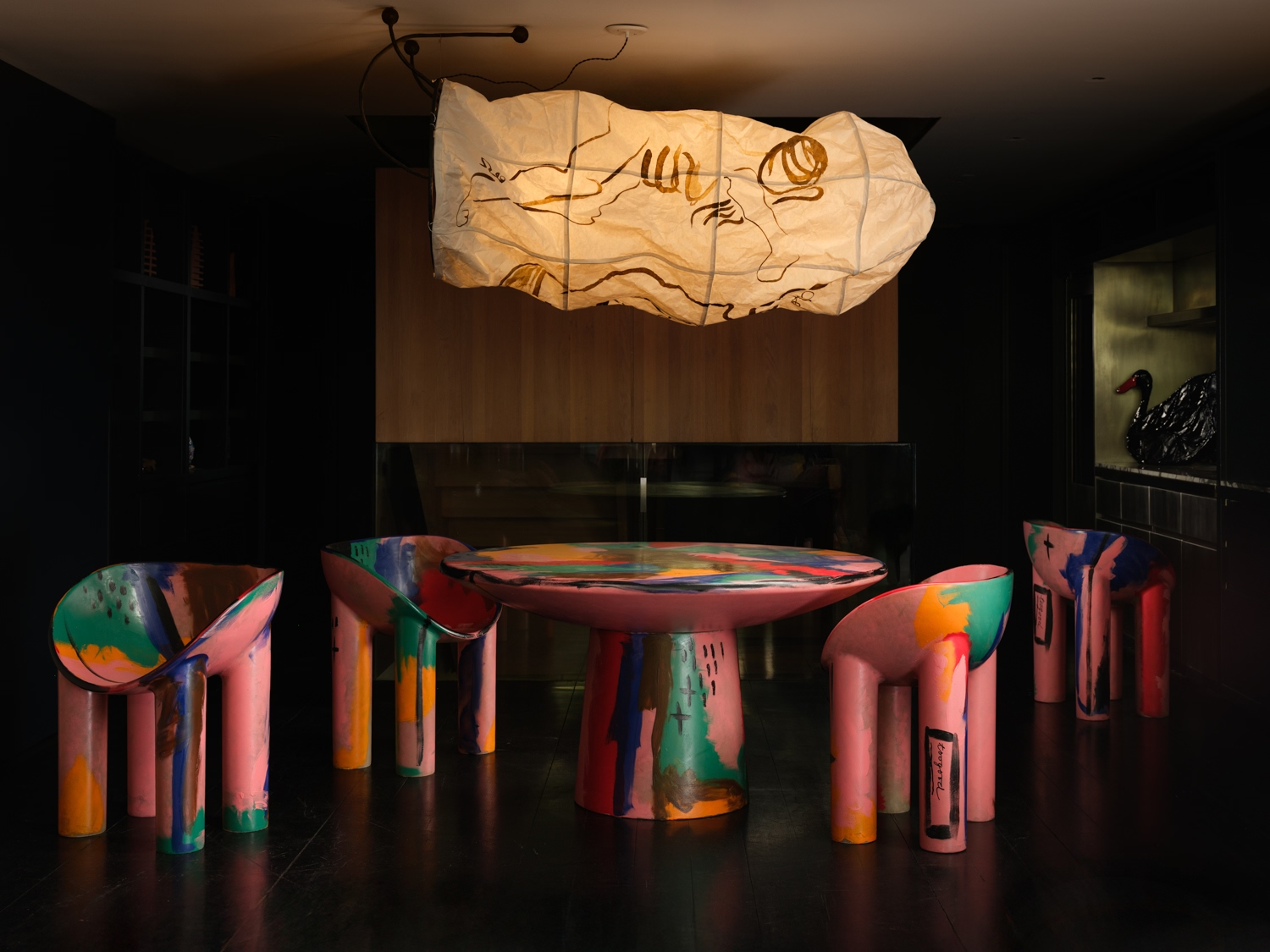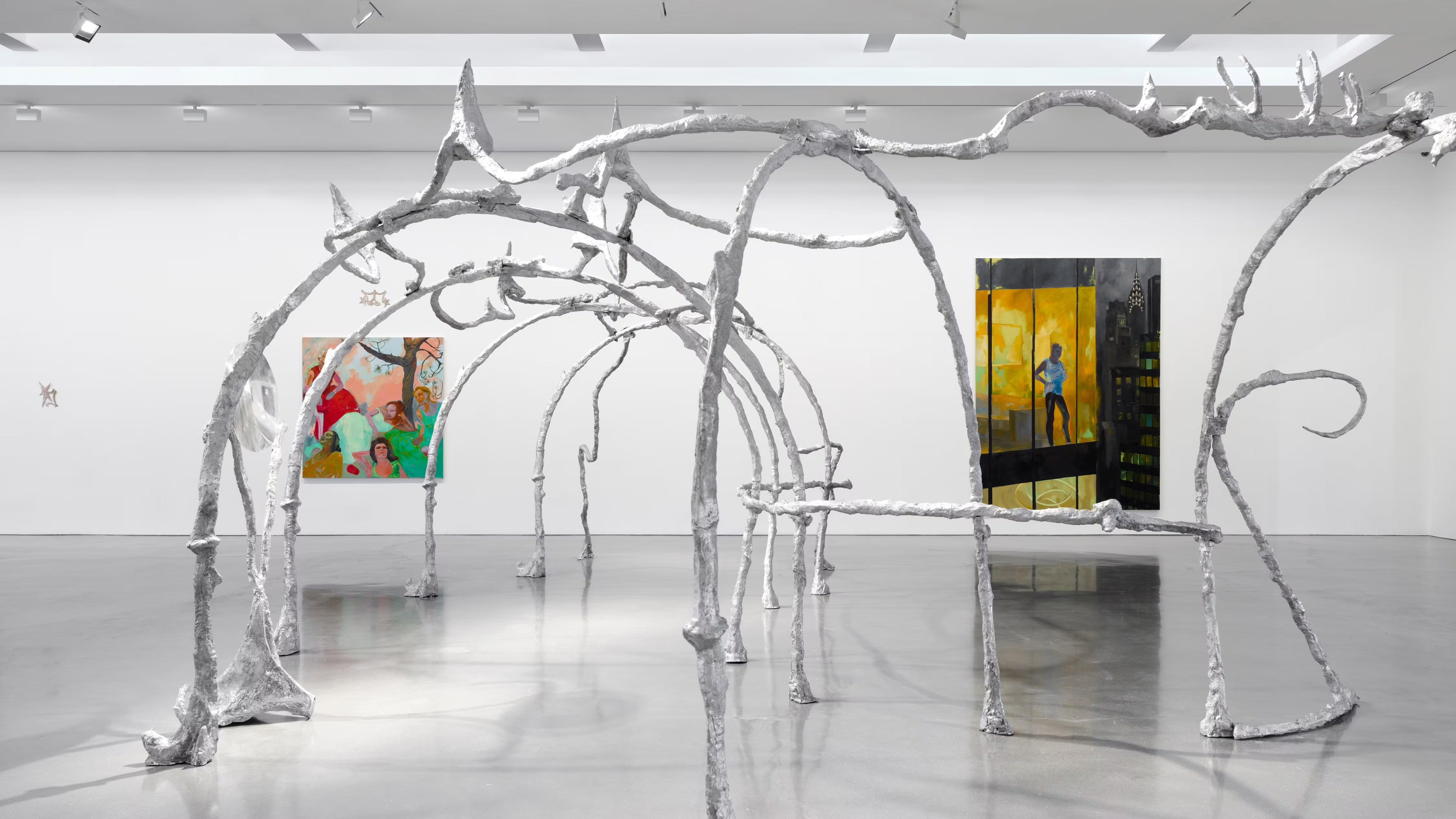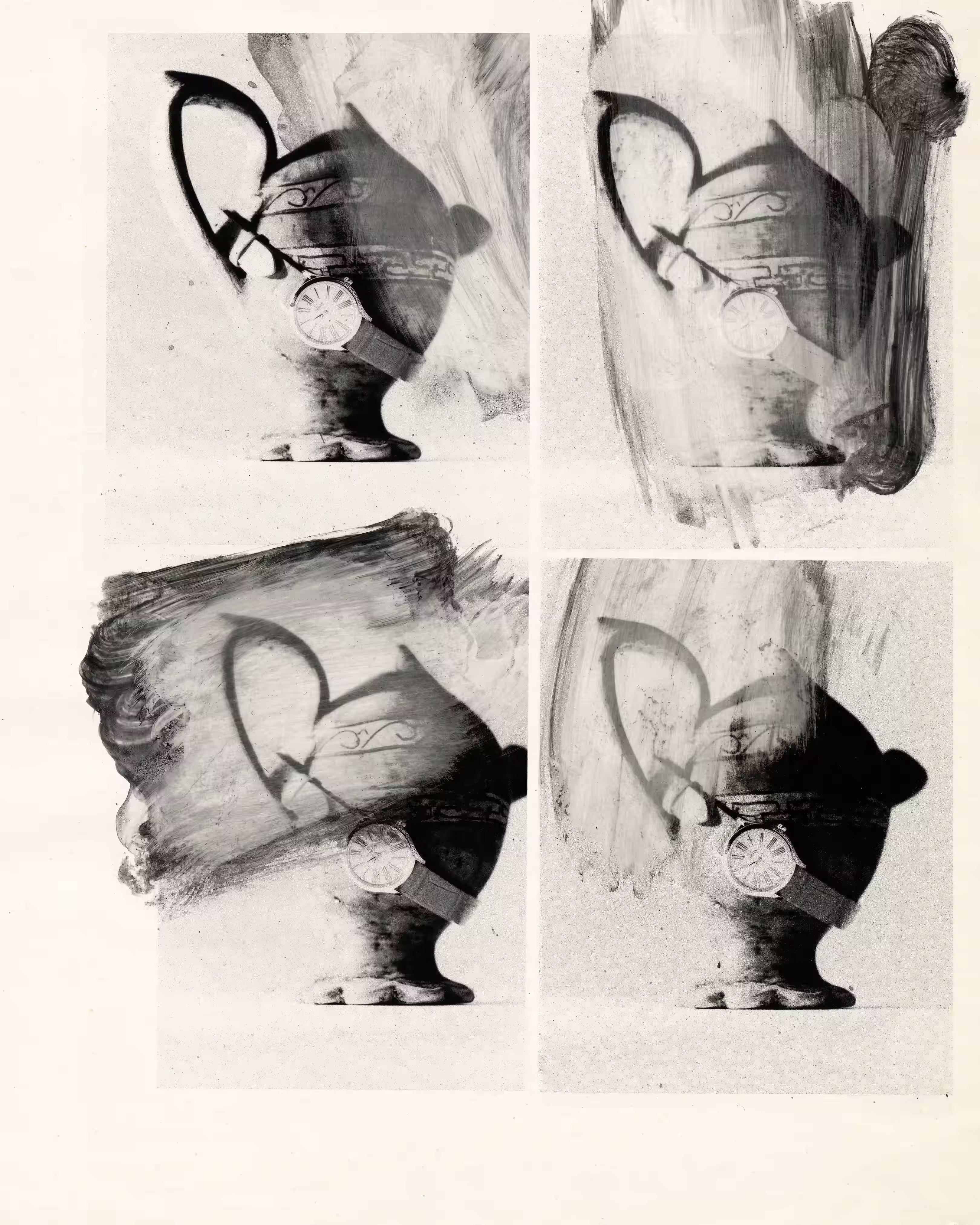
“Stags' Leap, Mount Veeder, Miwok, Ohlone, Monterosso, Carneros.” Abraham Cruzvillegas is reciting a list as he debuts a pair of murals titled "Two Abstract Maps (An Alchemical Self Portrait)," 2024 at Louis M. Martini Winery in St. Helena, California. “This sounds like a poem, but it's in fact the names of native people's sites and wineries around here,” says the interdisciplinary artist. “This map is very meaningful in terms of human activity and destruction—but also in creation, possibility, and togetherness, and perspective of the future.”
Dressed in a black, raw-hemmed Yohji Yamamoto suit, a white button-down, and a blue, patterned necktie, Cruzvillegas’ oversized glasses change from dark to clear as we settle into the winery’s tasting room, and his eyes come into focus. He is standing at a table with a spread of seasonal dishes prepared by his friend, the Mexico-city based chef, Elena Reygadas. Behind him, his sculpture-mural is affixed onto the wall. This white constellation-like mapping of the aforementioned sites is as symbolic as it is prescriptive. It is the second installment of the winery’s new art program curated by Georgia Horn, which invites contemporary artists to create site-specific works that explore the connection between art and winemaking. “He is meeting the landscape and the place where it is, not trying to bend it to his own will,” says Horn.

Before he created the murals, the Mexico City-based artist immersed himself in the history of the winery and its environment, both constructed and organic. He points to the hands of workers picking the grapes, many of them immigrants from Michoacán, as the link between humanity and nature. “I didn't look for material, I just found it here,” he says of the works’ terra-cotta tiles, leftover from the winery’s renovation, arranged as a constellation of cut-out strips and bolt-like shapes, and painted a pale green.
Outside, a companion mural is carved into the building’s exterior. (Cruzvillegas likens the two pieces to parenthesis that frame the winery.) Nature-map charts native foliage like manzanita shrubs and the local species like gophers. As we discuss his maps, we are confronted by the limits of the English language, one of many that the artist speaks, and its heavy, colonial subtext. “Indigenous nations in Mexico and Indonesia and the Yoruba people in Africa each have their own word for map,” he says.
%20(1).avif)
Cruzvillegas’ maps underscore cartography’s use as a tool to dominate, erase, and divide—and offer an alternative way forward. “In the Western perception, maps mean ‘this belongs to me’ or ‘this belongs to the crown,’” he explains. “I understand the future in a more hermeneutical way: throwing stones to read the future or or playing with shells.” The artist looks beyond paradigms, to the shapes in the clouds, the roots beneath the ground, the moles on a loved one’s face. He finds patterns in the stars and charts them in his work.
The artist was born in 1968, on the southern edge of Mexico City, in the Colonia Ajusco neighborhood. “It was a very hot year, politically,” he says, recalling how an awareness of authoritarianism swept over young people around the world. “We were trying to fight for change,” he says. Now, as corruption is rampant and natural disasters omnipresent, he looks to the next generation with hope that they can continue these efforts.

His mother is Hñhäñhu from what is now the state of Hidalgo. His father belonged to the P'urhépecha (“those who visit each other”), one of the remaining native cultures in Mexico, now known as the state of Michoacán. “He was born right after the Mexican Revolution and was not able to learn his language because the government wanted to make a monolithic cultural identity,” he explains adding, “there are some survivors who still speak their languages—survivors of this process of violence and structural aggression to destroy their cultures.”
As a child, Cruzvillegas would read the left-wing newspapers brought home by his activist parents. Everything was in service of anarchy: the music they played, the company they kept. In the late ‘80s, he began to study satirical drawings around the world. But from the very beginning of his practice, his concerns were three-dimensional. “A shoe is a shoe and a stone is a stone, but together they mean something else,” he says. “It is possible to add narrative, but at the gallery they should be seen as abstract: a shoe and a stone together.”
.avif)
To view the artist’s work is to construct meaning from a collection of disparate parts, “like when listening to a symphony.” Drawing from his native home-building practice of autoconstrucción, his art evolves over time, with material sourced from wherever he is, as well as locally specific information, from history, to economics to politics. “Who names the north and south when everything is upside down?” he asks. Like more straight-forward political cartoons, his art provokes disturbing quotations: Where do we come from? Who are we? What can we do to make a better world? “I'm not producing solutions, but I'm pointing at the problems in different ways,” he offers.
“Mexico is a transit country on the way to the U.S.,” he explains. “We have many problems, including natural, environmental problems, political corruption, drug dealing, and all the etceteras you can imagine.” In 2001, Cruzvillegas met his wife Alejandra, a lawyer who works with refugees and asylum claimants for the United Nations. While he is hesitant to speak about her work in specifics, he concedes that she has taught him a great deal about the situations around the world. As he sees it, everything can be changed—save for geography. “We are attached to America,” he says.“This means that people are exposed to different problems on the way to the US because of the policies of the states that have been complicating the lives and expectations of displaced people.”

While the artist has a deep understanding of the plight of those seeking asylum in both Mexico and America, he refrains from explicitly addressing it as a subject matter. “It's something that I can better help or support in different ways,” he explains. “Making an artwork related to that would be good, but it's not enough. “I'm not an activist. I'm an artist,” he suggests. “If I want to protest against anything, I go to the street.” He pauses, “But of course I can be both: I'm a son, I'm a husband, I'm a friend, sometimes I’m a cook.” For Cruzvillegas, identity is diverse, a series of phases: contradictory and continuously morphing. Yet, to be one thing does not negate or deny the other. It is beyond Western perception, unfettered by capitalism. “But we are still part of this world,” he concedes, “and it demands us to be efficient, logical, stable, coherent, and smart,” he pauses, “I'm not, but I can be.”
This slippage is something the artist includes in his work as both a concept and a method. As he layers subtexts he builds a liminal space where language stops and politics coalesce but art flows freely. Ideas snowball across space and time, indifferent to contradiction. Identity follows suit, and meaning begets meaning in a möbius loop, but Cruzvillegas is resolute in his statements: “If I say my government is corrupt, it's corrupt. If I say my country Mexico is authoritarian, it is. I would not deny it. If I say we are destroying the environment, we are,” he emphasizes. And then: “If I say my work is not illustrating a subject matter, it doesn't.”
Abraham Cruzvillegas, Two Abstract Maps (An Alchemical Self Portrait), 2024 is permanently on view at Louis M. Martini Winery in St. Helena, California at 254 St Helena Hwy, St Helena, CA 94574.











.avif)








.avif)


_result_result.avif)



.avif)

_result_result.avif)

_result_result.avif)
.avif)

_result_result.avif)


_result_result.avif)


.avif)




.webp)

.avif)



















%20(1).avif)
.avif)




.avif)
















.avif)


.avif)





















.jpeg)

.avif)

_11%20x%2014%20inches%20(2).jpg)







.avif)

.jpg)

%20(1).jpg)
.avif)
.jpg)

.jpg)
.webp)


.webp)



.webp)


.webp)


.avif)









.avif)
.avif)

















.avif)









.avif)



.avif)



















-min_result.avif)









.avif)







3_result.avif)
_result.avif)






_result.avif)




.avif)




.avif)













.avif)

.avif)











.avif)

.avif)










.avif)



.avif)


_result_result.avif)
















-min_result.avif)






.avif)
.jpg)
















_result.avif)

.avif)


.avif)







.avif)





.avif)

_result.avif)



.avif)















.avif)









.avif)


.avif)














.avif)




.avif)








.avif)

.avif)

.avif)



.avif)


.avif)




.avif)

.avif)

.avif)
.avif)
%20(1).avif)
.jpg)

%20(1).avif)








.avif)
.avif)

.avif)






.avif)



















.avif)
.avif)
